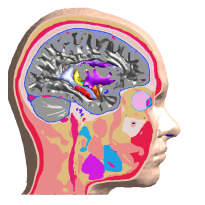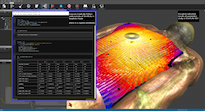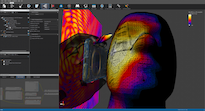 Sim4Life computer-aided design multi-phyics, multi-physilogy-response-model simulation platform.
Sim4Life computer-aided design multi-phyics, multi-physilogy-response-model simulation platform.
 Highly detailed anatomical models in Sim4Life.
Highly detailed anatomical models in Sim4Life.
 Parametric study of wireless power transfer exposure in Sim4Life.
Parametric study of wireless power transfer exposure in Sim4Life.
 Millimeter wave compliance assessment in Sim4Life.
Millimeter wave compliance assessment in Sim4Life.
Sim4Life
Sim4Life is the advanced computational platform, co-developed by IT’IS and ZMT Zurich MedTech AG for technical system design (e.g, mobile phones) and biomedical simulations (e.g., vagus nerve stimulators) on and within the full human anatomy.
Sim4Life is available as a desktop version and also as a fully native web-based application Sim4Life.web.
Background
Computational simulation methods are one of the main pillars of research activities at IT'IS. First, we focused on the development of a powerful electromagnetic (EM) solvers, which became the core of the full-wave 3D EM simulation software SEMCAD X that is now part of sim4Life. Together with the University of Calgary as well as NVIDIA, IT’IS was the first to use clusters of graphics processing units to overcome the limits of problem complexity, an approach that is now state-of-the-art.
Over the last 15 years, we have acquired more and more projects to address scientific questions that require modeling of various physical interactions and processes in living tissue and human physiology. In the work on these projects, we have greatly advanced the capabilities of the physical and physiological solvers used to handle the most detailed computational animal (ViZoo) and human Virtual Population anatomical models (25+ different body types with 120 vital anatomical features and over 300 precisely identified tissues and organs). Together with ZMT, we regularly integrate new tools into our Sim4Life platform and make it sustainably available to our partners and the industry.
Sim4Life Desktop and Web Version
Sim4Life is available as a desktop and web version. The two versions are identical twins, offering seamless integration and excellent responsiveness, which means users can effortlessly switch between the two platform versions for a smooth and uninterrupted workflow.
The web version relies on our o2S2PARC cloud-based technology and represents another technological breakthrough, as it is the first natively implemented advanced simulation tool on the web.
Together with the web version for commercial use, ZMT has also released Sim4Life.science at much lower cost for non-profit research organizations.



